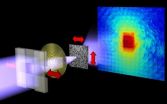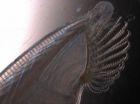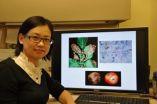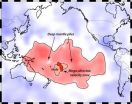(Press-News.org) Since the observations made by English naturalist Charles Darwin on the Galapagos Islands, researchers have been interested in how physical barriers, such as isolation on a particular island, can lead to the formation of new species through the process of natural selection. Natural selection is a process whereby heritable traits that enhance survival become more common in successive generations, while unfavorable heritable traits become less common. Over time, animals and plants that have morphologies or other attributes that enhance their suitability to a particular environment become more common and more adapted to that specific environment.
Researchers today are intimately familiar with how physical barriers and reproduction isolation can lead to the formation of new species on land, especially among plants and animals with short generation times such as insects and annual plants. Michael E. Hellberg, associate professor in the Department of Biological Sciences at LSU, however, is interested in a more obscure form of speciation: the speciation of animals in the ocean.
"Marine plants and animals can drift around in the ocean extremely long distances," Hellberg said. "So how do they specialize?"
In a recent publication in the Proceedings of the National Academy of Sciences, or PNAS, Hellberg and his graduate student Carlos Prada investigate how corals specialize to particular environments in the ocean. Corals, animals that form coral reefs and some of the most diverse ecosystems in the world, start their lifecycle with a free floating larval stage. Coral larvae can disperse vast distances in open water. Different coral species share similar geographical locations, with different species often existing only yards apart. As Prada and Hellberg propose in their recent publication, the large dispersal potential of coral larvae in open water and the proximity of different species on the ocean floor creates a mystery for researchers who study speciation. Hellberg and Prada ask, "How can new marine species emerge without obvious geographic isolation?"
When it comes to corals within the relatively small confines of the Caribbean, which spans approximately 3 million square kilometers, the key to the puzzle appears to be habitat depth in the ocean. In others words, natural selection has led to the formation of different coral species according to how deep in the ocean these different corals grow.
Prada and Hellberg study candelabrum corals of the genus Eunicea, generally known as "sea fans," for which sister species have been shown to be segregated by ocean depth. One sister species survives better in shallow waters, while the other is better adapted to deep waters. These corals, like other corals, are very slow-growing animals. In fact, sea fan corals don't reach reproduction age until they are 15-30 years old, and can continue reproducing until they are 60 or more years old. So while candelabrum coral larvae can disperse large distances from their parents, landing and beginning to grow in either shallow or deep water habitats, small differences in survival rates at different depths between the two species and long generation times can combine to produce segregation.
"When these coral larvae first settle out after dispersal, they are all mixed up," Hellberg said. "But long larvae-to-reproduction times can compound small differences in survival at different depths. By the time these corals get to reproduction age, a lot has changed."
The shallow water sea fan coral even has a different morphology than its deep water sister. The shallow water coral fans out into a wide network of branches, while the deep water coral grows tall and spindly. According to Hellberg, these differences in morphology might well be genetic, with the different corals having different protein structures and levels of expression that are better adapted to their specific water depth environment. Hellberg hopes in future research to investigate the genetic basis of these different morphologies.
In other interesting results, Prada explained how transplanting the shallow coral species to deep water environments, and vice versa, can cause the coral to take on a morphology more like that of its sister species.
"Their morphologies are not super fixed," Prada said. "But they can't change all the way to a different morphology."
Prada observed that while shallow water sea fans can become taller and more spindly when transplanted in deep water environments, they don't seem to be able to make a complete transition to the morphology of the deep water sea fan. This suggests that the two corals, while they likely had a common ancestor, have adapted genetically and biochemically to their respective water depths.
Prada did ocean dives in the Bahamas, Panama, Puerto Rico and Curaçao to sample candelabrum coral colonies. Back in the lab, he performed tests on the coral samples' genes to determine how shallow and deep corals become genetically different.
"Normally, organisms are differentiated by geography," Prada said. "But these corals are differentiated by depth."
Prada and Hellberg's research provides new insights into how new species form in the ocean, a topic of relatively limited research as opposed to speciation of terrestrial organisms.
INFORMATION:
To read the original paper, visit http://www.pnas.org/content/early/2013/01/22/1208931110.
Visit the Hellberg lab website, http://www.mhellberg.biology.lsu.edu/.
END
ANN ARBOR—Hunger, thirst, stress and drugs can create a change in the brain that transforms a repulsive feeling into a strong positive "wanting," a new University of Michigan study indicates.
The research used salt appetite to show how powerful natural mechanisms of brain desires can instantly transform a cue that always predicted a repulsive Dead Sea Salt solution into an eagerly wanted beacon or motivational magnet.
Mike Robinson, a research fellow in the U-M Department of Psychology and the study's lead author, said the findings help explain how related brain activations ...
AUDIO:
In the 1970s and early 1980s, some states lower their minimum legal drinking age below the age of 21. Those lower drinking ages have been linked to bad things, from...
Click here for more information.
People who grew up in states where it was legal to drink alcohol before age 21 are more likely to be binge drinkers later in life, according to a study by researchers at Washington University School of Medicine in St. Louis.
The findings are available online in Alcoholism: ...
For more than 100 years radiography meant: don't move! In order to visualize nanostructures such as biological cells, the porous structure of cement or storage fields of magnetic disks, the experimentators had to avoid any kind of vibration of X-ray microscope and sample. In addition, only a small percentage fraction of the incoming X-ray radiation could be used. Using special filters, they had to select exactly the fraction with the right properties – for example, the right wavelength.
Contributions of different wavelengths separated
Pierre Thibault of the Technische ...
CHICAGO -- Feeding human breast milk to very-low-birth-weight infants greatly reduces risk for sepsis and significantly lowers associated neonatal intensive care unit (NICU) costs, according to a study by Rush University Medical Center researchers.
The study, published Jan. 31 in the advance online version of the Journal of Perinatology, showed that every 10 milliliters of human milk per kilogram that a very low birth weight infant received during the first 28 days of life decreased the odds of sepsis by almost 20 percent.
A daily dose of 25 to 49.99 milliliters of ...
WOODS HOLE, MASS. -- Among the animals that are appealing "cover models" for scientific journals, lancelets don't spring readily to mind. Slender, limbless, primitive blobs that look pretty much the same end to end, lancelets "are extremely boring. I wouldn't recommend them for a home aquarium," says Enrico Nasi, adjunct senior scientist at the Marine Biological Laboratory (MBL). Yet Nasi and his collaborators managed to land a lancelet on the cover of the Journal of Neuroscience last December. These simple chordates, they discovered, offer insight into our own biological ...
RIVERSIDE, Calif. — When a pathogen attacks a plant, infection usually follows after the plant's immune system is compromised. A team of researchers at the University of California, Riverside focused on Phytophthora, the pathogen that triggered the Irish Famine of the 19th century by infecting potato plants, and deciphered how it succeeded in crippling the plant's immune system.
The genus Phytophthora contains many notorious pathogens of crops. Phytophthora pathogens cause worldwide losses of more than $6 billion each year on potato (Phytophthora infestans) and about ...
SALT LAKE CITY, Feb. 7, 2013 – A University of Utah seismologist analyzed seismic waves that bombarded Earth's core, and believes he got a look at the earliest roots of Earth's most cataclysmic kind of volcanic eruption. But don't worry. He says it won't happen for perhaps 200 million years.
"What we may be detecting is the start of one of these large eruptive events that – if it ever happens – could cause very massive destruction on Earth," says seismologist Michael Thorne, the study's principal author and an assistant professor of geology and geophysics at the University ...
Cancer drugs of the new, molecular generation destroy malignant breast tumors in a targeted manner: They block characteristic molecules on tumor cells - receptors for the hormones estrogen or progesterone, or a co-receptor, called HER2, that binds to many growth factors. But about one in every six breast tumors has none of these receptors. Such cancers, called triple-negative, are particularly aggressive and notoriously difficult to treat.
Some of these therapy-resistant cancers have a potential molecular target for cancer drugs, a growth-factor receptor called EGFR, ...
Scientists hope that one day in the distant future, miniature, medically-savvy computers will roam our bodies, detecting early-stage diseases and treating them on the spot by releasing a suitable drug, without any outside help. To make this vision a reality, computers must be sufficiently small to fit into body cells. Moreover, they must be able to "talk" to various cellular systems. These challenges can be best addressed by creating computers based on biological molecules such as DNA or proteins. The idea is far from outrageous; after all, biological organisms are capable ...
Caving in to social pressure — such as saying that you love a movie because friends do — makes for good vibes about being part of a group and can produce more of the same conduct, according to a Baylor University sociological study. The finding has implications for people ranging from philanthropists to gangs, researchers said.
"The punch line is very simple: Conformity leads to positive feelings, attachments, solidarity — and these are what motivate people to continue their behavior," said Kyle Irwin, Ph.D., an assistant professor of sociology at Baylor and lead author. ...




